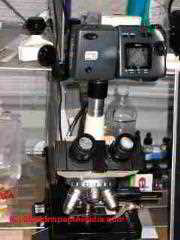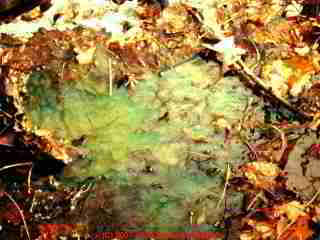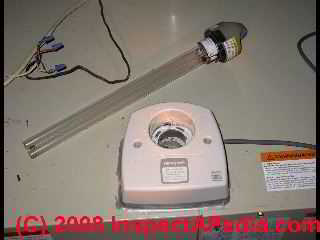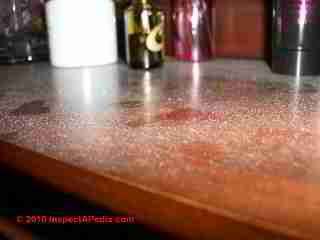 Using Light in Environmental Testing or Forensic Building Investigations
Using Light in Environmental Testing or Forensic Building Investigations
- POST a QUESTION or COMMENT about the use of light, lighting, light levels, reflected light, transmitted light, polarized light, UV light or black light, and light color or wavelengths in forensic, building and microscopic investigations
How to use light in building forensic or environmental investigation work in the field and in the test laboratory.
This article describes the optimum use of light & types of lighting in building & forensic investigations.
We describe examples and provide links to detailed information about how the angle, color, frequency, intensity, and other aspects of lighting can make it either possible or impossible to detect various particles and substances.
InspectAPedia tolerates no conflicts of interest. We have no relationship with advertisers, products, or services discussed at this website.
- Daniel Friedman, Publisher/Editor/Author - See WHO ARE WE?
Optimum Adjustments & Uses of Infra Red, Visible Light, & UV Light in Building, Environmental & Forensic Investigation
The range of "light" illumination, colors, and energy levels useful in building & environmental investigations includes both the entire visual spectrum and also sensors in the infrared and ultraviolet ends of the spectrum that have special applications. Here we describe the range of light and light uses in forensic work.

As our pair of photographs above illustrate, careful use of lighting can make airborne particles quite apparent. (Discussed
at INDOOR AIR QUALITY IMPROVEMENT GUIDE).
A Catalog of Effective Use of Light in Building Investigations, Environmental Testing, & Forensic Investigations
ASBESTOS UNDER the MICROSCOPE - using polarized light microscopy (PLM) and darkfield microscopy for asbestos identification. McCrone illustrated that tremolite asbestos (as well as some other forms of asbestos) occur in both fibrous and non-fibrous form.
Comparing the photo at below left (tremolite in fibrous form) by McCrone to ours (below right) that shows fewer small non-fibrous particles, but a clear bundle of ultra-fine sub-micron (in width) fibers.
and
ASBESTOS FLOOR TILE LAB PROCEDURES provides further examples of polarized light microscopy

BLOOD in ART WORKS, TESTING FOR fluorescent light & luminol quick tests for blood require additional steps to confirm human blood
CARPET STAIN DIAGNOSIS - includes of course stains from mold, pet urine, or worse.
Also see CARPET STAIN ID TESTS and CARPET CONTAMINATION TEST PROCEDURE.
And see URINE / ANIMAL ODORS IN BUILDINGS .
Color Temperature Bulb Comparisons is a helpful article for understanding the forensic use of light in building investigations. We illustrate how some objects can appear as very different colors under differing light sources.
DUCT SYSTEM DESIGN SIZE & DEFECTS - how to find, clean up or remove, or prevent contamination problems and indoor air quality problems in duct systems: asbestos, fiberglass, flooding, mold, water, and other duct contaminants
EFFLORESCENCE SALTS & WHITE DEPOSITS - don't confuse efflorescence with fluoresence discussed in our UV light articles (below).
GAS BURNER FLAME & NOISE DEFECTS - observing flame color indicates level of combustion & combustion air defects - illustrated in our photo at left. More details are at FLAME COLOR, BLUE vs YELLOW COMBUSTION
GAS LIGHTING, PIPES, FIXTURES - detection of antique gas piping that may still be "live", a fire & gas hazard in buildings
GREENHOUSE / SUNSPACE GLARE illustrates how too much light or light that is too direct can actually be blinding
INDOOR AIR QUALITY IMPROVEMENT GUIDE - using light and angle of light correctly can make it easier to spot settled dust on building surfaces, aiding in sample collection, as well as providing more subjective spotting of airborne particulate debris as we illustrated in the pair of photos earlier on this page.
THERMOGRAPHY IR Infra Red & THERMAL SCANNERS - Thermal scanners or infra red IR scanners and thermography cameras ease finding points of heat loss or air infiltration in buildings.
See HEAT LOSS DETECTION TOOLS and also ALUMINUM WIRING HAZARDS & REPAIRS where we provide an example of aluminum wiring overheating.
LAB IDENTIFICATION OF FIBERGLASS - includes a discussion of the importance of the use of proper refractive index liquid & polarized light for identification of these materials.
Laser light inspection methods - [in process] [20]
LIGHT AIM FINDS MOLD & OTHER PARTICLES - how to use oblique lighting to find mold contamination or other surface dust contaminants in buildings
LIGHT, FLASHLIGHT for MOLD - know how to aim a flashlight during building investigations: oblique vs. direct reflected light
Our photo illustrates the appearance of light colored mold contamination on a building wall - a contaminant that was impossible to see with the naked eye unless light was aimed on an oblique angle.
LIGHT, GUIDE to FORENSIC USE - a guide to effective use of light levels, direction, color, frequency & methods for forensic investigation
LIGHTING, EXTERIOR GUIDE - recomended types, ambient levels, illumination levels for various tasks & building areas, outdoors
LIGHTING, INTERIOR GUIDE - recomended types, ambient levels, illumination levels for various tasks & building areas, indoors

MICROSCOPE TECHNIQUES for the LAB: use of transmitted light, reflected light, polarized light, darkfield, refractive index liquids, & the POLAM tilting color filter stage for variation in wavelength of transmitted light for particle identification.
The POLAM filter stage allows particle identification without resorting to a full set of refractive index liquids. Top lighting allows us to quickly distinguish between certain very round fungal spores and spray paint droplets of the same size range.
Polarized light combined with measures angular rotation through the polarized field allows very accurate fiber and other particle identification.
OPTIMUM INDOOR AIR FILTERS - use of UV light in duct work & air handlers to retard biological contaminant growth
PAINT ANALYSIS, DIAGNOSTIC USES provides examples of use of microscopy and reflected light microscopy or top lighting to examine the causes of paint failures and to detect paint particles in air, dust or surface samples.
Also see PAINT LAB SAMPLE PREPARATION.
Polilight and similar devices can provide a light source of variable wavelength for widely applicable forensic uses. [23] This approach is similar to that used our Russian-designed POLAM microscope described just above.

SEPTIC DYE TEST PROCEDURE - using a fluorescein septic dye, usually green (photo at left) or red can detect even very dilute presence of tracer dye in septic tank or drainfield failures, leaks, and contamination of surfaces or wateways
STAIN DIAGNOSIS on BUILDING EXTERIORS
and STAIN DIAGNOSIS on BUILDING INTERIORS can benefit from use of ultraviolet light for detection
of URINE / ANIMAL ODORS IN BUILDINGS - also see
UV LIGHT BLACK LIGHT USES - for detection of human & animal bodily fluids, urine, blood, and many other fluorescing materials
UV WATER DISINFECTION, PORTABLE

UV light treatment in the duct system or air handler (photo above left) is available for HVAC systems and may be slightly helpful for areas where occupants are at extreme medical risk.
See OPTIMUM INDOOR AIR FILTERS. At above right, a UV light is installed on a private well water system.
See UV ULTRAVIOLET LIGHT WATER TREATMENT - partial purification of water by UV to kill bacteria. Other treatment methods may be needed if Giardia is present in the water supply.
Proper Angle of Light to Observe Particles in both Macro (house dust) and microscopic (fine particle) studies
Proper angling of lighting or a flashlight allows much more effective discovery of settled dust on building surfaces (photo, below left). In the forensic lab a study of this dust found typical fabric fibers, skin cells, starch granules.
Discussed at LAB IDENTIFICATION OF FIBERGLASS.

Without use of a mounting liquid of the proper refractive index range and proper microscope adjustment it can be difficult or even impossible to detect small fiberglass fragments in air and dust samples. Use of polarized light with proper mountants can also quickly confirm that fibers found in an environmental sample are fiberglass.
At below left the concoidal fractures on the ends of fibers is confirming evidence of that this is a glass or fiberglass fiber. At below right, the presence of resin on the fiber is also indicative.
Also see FIBERGLASS PARTICLE CONTAMINATION TEST.

VISUAL PERCEPTION ERRORS - The Nature of Vision - Inspecting Complex Systems, Why We See or Do Not See Things We Are Looking For - Or Should Be Looking For
The articles listed below provide examples of forensic and other uses of light, light instruments, and light wavelengths pertinent to building science & environmental testing.
...
Continue reading at LIGHT AIM FINDS MOLD & OTHER PARTICLES or select a topic from the closely-related articles below, or see the complete ARTICLE INDEX.
Or see these
Recommended Articles
- AIRBORNE PARTICLE ANALYSIS METHODS
- ASBESTOS in TALCUM POWDER
- BLOOD in ART WORKS, TESTING FOR
- DUST ANALYSIS for FIBERGLASS
- FORENSIC INVESTIGATION of BUILDINGS
- FORENSIC LAB TECHNICAL PROCEDURES
- LIGHT AIM FINDS MOLD & OTHER PARTICLES
- LIGHT, GUIDE to FORENSIC USE
- MICROSCOPE SLIDE PREPARATION
- PAINT ANALYSIS, DIAGNOSTIC USES
- SEPTIC DYE TEST PROCEDURE
- STAIN DIAGNOSIS on BUILDING EXTERIORS
- STAIN DIAGNOSIS on BUILDING INTERIORS
- URINE / ANIMAL ODORS IN BUILDINGS
- THERMOGRAPHY IR Infra Red
- THERMAL SCANNERS
- UV LIGHT BLACK LIGHT USES
- VISUAL PERCEPTION ERRORS
Suggested citation for this web page
LIGHT, GUIDE to FORENSIC USE at InspectApedia.com - online encyclopedia of building & environmental inspection, testing, diagnosis, repair, & problem prevention advice.
Or see this
INDEX to RELATED ARTICLES: ARTICLE INDEX to BUILDING & HOME INSPECTION
Or use the SEARCH BOX found below to Ask a Question or Search InspectApedia
Ask a Question or Search InspectApedia
Try the search box just below, or if you prefer, post a question or comment in the Comments box below and we will respond promptly.
Search the InspectApedia website
Note: appearance of your Comment below may be delayed: if your comment contains an image, photograph, web link, or text that looks to the software as if it might be a web link, your posting will appear after it has been approved by a moderator. Apologies for the delay.
Only one image can be added per comment but you can post as many comments, and therefore images, as you like.
You will not receive a notification when a response to your question has been posted.
Please bookmark this page to make it easy for you to check back for our response.
IF above you see "Comment Form is loading comments..." then COMMENT BOX - countable.ca / bawkbox.com IS NOT WORKING.
In any case you are welcome to send an email directly to us at InspectApedia.com at editor@inspectApedia.com
We'll reply to you directly. Please help us help you by noting, in your email, the URL of the InspectApedia page where you wanted to comment.
Citations & References
In addition to any citations in the article above, a full list is available on request.
- In addition to citations & references found in this article, see the research citations given at the end of the related articles found at our suggested
CONTINUE READING or RECOMMENDED ARTICLES.
- Carson, Dunlop & Associates Ltd., 120 Carlton Street Suite 407, Toronto ON M5A 4K2. Tel: (416) 964-9415 1-800-268-7070 Email: info@carsondunlop.com. Alan Carson is a past president of ASHI, the American Society of Home Inspectors.
Thanks to Alan Carson and Bob Dunlop, for permission for InspectAPedia to use text excerpts from The HOME REFERENCE BOOK - the Encyclopedia of Homes and to use illustrations from The ILLUSTRATED HOME .
Carson Dunlop Associates provides extensive home inspection education and report writing material. In gratitude we provide links to tsome Carson Dunlop Associates products and services.











